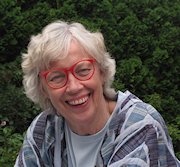

I have just celebrated 17 years since my diagnosis of stage III-3 ovarian cancer and surgery in January 1998. While I spent years fearing a recurrence, I am fortunate to have fallen into that group of women who are treated and can get on with their lives. But while I have gotten on with my life, I am still connected and involved with the other women I met early-on.
Like many of these women, I was astonished by my diagnosis. I was a 58 year old woman feeling strong and at home in my world. I loved my work with middle school and high school students. I felt at home in my school community and was connected to a wide segment of Portland’s art community. Those connections would prove to be lifesaving as I moved through diagnosis, surgery and treatment.
In fact, at the end of that first year I made a list of people who’d helped me get through it. In creating that list I filled an entire sheet of notebook paper. Even with the distance of 17 years since I was initially diagnosed and treated, I still feel a bond with, and gratitude for, those people who found ways to assist me during treatment.
I’m reminded today that offers of help and support can be something small, yet still have the power to shift feelings of loneliness and despair. For me, gifts from friends that really helped included: rides to medical appointments; books that carried me to distant places; funny videos (Fawlty Towers comes to mind); or simply coming to be present while I showered. One friend even took me to see his favorite fishing hole. I think that the intent of the giver and the depth of his/her concern was the connection that tethered me to earth.
I felt like I had walked through a gate into a walled garden. Suddenly I was experiencing vulnerability and my medical team was calling the shots. To get back in touch with invincible me, I saw an art therapist who helped me deal with fear of recurrence; I had several acupuncture treatments for neuropathy; and I traveled to New York for a second opinion (and to store up some visual images and memories). A trip to France to see the cave paintings at Lascaux II filled my parched spirit just two weeks after I’d finished chemo.
I heard that taking part in a support group doubled a patient’s chances of survival. When I thought about the side effects of some of my other forms of treatment I was getting, attending a support group seemed like a breeze. About that time, I saw a small article in the newspaper about the formation of the Gynecological Cancer Support Group (at Legacy Good Samaritan Hospital). It took me a while to find out where it met, and when I first attended were only five of us – including the moderator. Importantly, though, I’d found “my pack.” I learned so much from those women who were sharing research with each other and laughing about daily events that accompany survival.
I have stayed involved with the group since that first meeting. Why? Maybe this is because I am a survivor who has lived 17 years without a recurrence of ovarian cancer, and I can remember asking friends to “tell me the name of one person you know who has had ovarian cancer and lived.” I was given the names of two women. I still recall who they were and how they were related to my friends. Now, I am that example of a woman who has had ovarian cancer and lived many years beyond it.
Nine years ago I discovered that I was BRCA1 positive. Since then, I have danced between my own concerns about having the BRCA gene mutation and the concerns of my family. Carrying the BRCA1 gene mutation has not been easy news for other family members — this is really not a family trait one wishes to have.
I have learned that there are groups that exist to help women with hereditary breast and ovarian cancers including F.O.R.C.E. (Facing Our Risk of Cancer Empowered), which offers support, education and other resources.
I am involved with the Ovarian Cancer Alliance of Oregon and SW Washington and have volunteered on some of the alliance’s projects like working at the Eugene Half Marathon (at the finish line). For the last ten years, I have been retired from teaching middle and upper school art at a small independent school in Portland. On warm, sunny days, I can be found floating in my beautiful kayak on various rivers in the Pacific Northwest.
In the fall of 2006, I drove to Santiago de Compostella from Bilbao in Spain, and on that path of Pilgrimage I was filled with gratitude for being the recipient of so much support from so many folks. I was overjoyed at simply being alive. When I found the “Door of Forgiveness” for those who are unable to complete the journey (it is in the town of Villafranca del Bierzo) – I felt the full rush of knowing how lucky I was to be right there and to be capable of reaching the goal. In February 2007, following the trip to Santiago, I gave a talk and exhibited related art work about my experiences with my illness and finding resilience.
Editor’s Note: Today, Judy continues her passion for creating art. She creates ceramics and paints, and has learned about bookbinding and the structure of handmade books. For several years she also co-taught a class at The Northwest Writing Institute called Visual Thinking.
